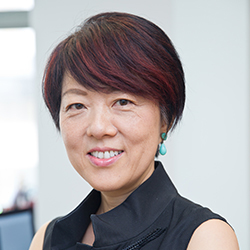 Ching-Hwa Sung:
Ching-Hwa Sung:
“I did my PhD in Taiwan where I trained as a cancer immunologist. Then I followed my husband to the US where he was doing a JHU PhD program.
I got a lot of postdoc offers from people at MBG, so I visited Johns Hopkins during the Christmas break. I met with many PIs, but I ended up choosing Jeremy Nathans’ lab. I went to his lab because I enjoyed working on disease mechanisms. He was younger than most of the department’s postdocs at the time!
Back then, I was one of the few postdocs from abroad in the department. Everyone came from such prestigious labs in the US, so I used to joke that I was from MIT because I was “Made in Taiwan.”
At the beginning of my postdoc, Jeremy spoke so quickly that I could usually understand about 50% of what he was saying. I told him he had to start speaking Chinese. Working with so many bright people was an eye-opening experience. I tell my students now: Don’t feel defeated by a smart mentor.
Jeremy gave me a lot of freedom to fly, and not just work under his shadow. It is hard for some graduate students and postdocs to break out from their mentor’s research. Jeremy encouraged our logical thinking skills, but he also gave us the freedom to do whatever we wanted. I really appreciated this training and the tools we were equipped with. He was also generous with offering me flexible hours when I had a child.
I enjoyed getting to know all the BCMB program faculty. Postdocs often have a hard time getting to know other faculty members. When I was a postdoc, everyone made dinners together on Thursday nights after work.
Two labs would get together: one lab would present its research and the other lab would cook. If you didn’t present, you had to cook dinner.
It was a great experience because you could talk about the science or the food. It took some of the pressure off knowing you were meeting casually.
I have a lot of fond memories from MBG. I really enjoyed my time at MBG, and at Johns Hopkins. I am part of a JHU alumni group now. We have a group chat and we help each other apply for awards and grants. We cheer each other on for good performance and we are happy to be JHU alumni. I have friendships that began at Hopkins and have lasted for decades.
Several years ago, 50 former Nathans Lab people attended a special reunion to celebrate the 30th anniversary of the Nathans Lab and present our current work. I rented a big Airbnb for some of us. It was fun to intermingle and see old friends and colleagues.
It was also amazing to see how a single person led to such a diversity of work among his trainees. If we are trained right, we can do anything we want, and that is powerful.
Now we just focus on our science and do our best. We focus on what we love to do. I still wake up in the morning and run to the lab because I love it.”
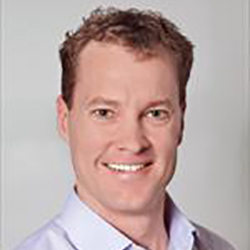 Dan Southworth:
Dan Southworth:
“I studied Molecular and Cell Biology at UC Santa Cruz. I did my thesis on RNA Biology and became interested in PhD programs at Johns Hopkins because of the integration between the basic sciences and medicine.
I was drawn to the BCMB program because it allowed me to look at broadly different labs and research programs. I rotated in the Cynthia Wolberger lab to learn x-ray crystallography and the Janice Clements lab to study HIV transcriptional regulation. Ultimately I returned to my interests in RNA and chose to do my PhD in Rachel Green’s lab to study ribosome biochemistry and protein translation.
I was the first PhD student in Rachel’s lab and enjoyed starting out in a small lab where the PI was at the bench much of the time, sharing results and advice. She received HHMI funding my second year there and the lab grew quickly. It was rewarding to see how a lab grows into a research team with additional students and postdocs and new projects developing out of ongoing results and discussions.
Rachel has a great presence in the lab – we would talk about results on a daily basis. Working side-by-side with your PI is an excellent experience for a graduate student.
Other memorable parts of my PhD were the weekly departmental seminars and happy hours. These were largely run by students and postdocs, and they were a great opportunity to interact casually and present research in progress with faculty and other members of the department.
I visited MBG a couple years ago to give a presentation. I met with many students and was reminded of my own time in the department. MBG offered an important foundational core for my interest in pursuing academic science. It drove my interest in becoming a PI and wanting to run my own lab.”
 Dorothy Sears:
Dorothy Sears:
“I have always been interested in science. I had some great science teachers when I was young and in 10th Grade, I thought I’d want to be a Genetic Engineer one day.
I did my undergraduate studies at the University of Southern California. I was particularly interested in Molecular Biology and Genetics. After I graduated, I worked in a lab at USC for a while before applying for graduate school.
I actually saw a poster on a wall advertising the BCMB program at Johns Hopkins. I was close with several faculty members at USC who encouraged me to apply.
I didn’t expect to be accepted – it was very much a dream school for me. But when I was asked to interview for the program, I was accepted on the spot.
I was somewhat conflicted about whether to enter the BCMB PhD program at Hopkins or accept one of my other offers to attend Human Genetics programs elsewhere, but many USC faculty members gave me the advice to select a program with broad training. They believed it was important to get a solid education and then become more specialized later. That was a big part of the reason for choosing JHU.
When I came to Hopkins, I knew I wanted to do Human Genetics. I had an idea of which labs I wanted to try out for rotations, but at that time, rotations were selected in alphabetical order based on your last name.
My last name started with an “S,” so by the time it was my turn, I was one of the last students to pick. All the labs I wanted were taken, but I remembered that a USC faculty member had recommended checking out Phil Hieter and his work.
I didn’t know who to pick for rotations, so I decided to work with Phil and it was awesome. The work I did in my rotation with Phil’s lab actually became a first-author paper, so I wanted to stay and continue my research.
Phil’s lab was a fun place to be with smart people. We had big stereo speakers and we would crank up the music while we were working. It wasn’t a big lab, which was great because you had many chances to get papers out. I had three first-author papers from my time in the BCMB program.
I also loved the bi-weekly dinners at MBG. During the academic year, each lab would host an on-campus dinner for the other labs. As host, the lab members brought dinner for attendees (many would cook using the little kitchen on the 5th floor). The host lab members would present their science before and after the dinner.
Trainees, postdocs, and even the PIs would talk about their work during these events. You would learn what people were doing one floor below you and hear about research you’d never know about otherwise. Since we were a Yeast Genetics lab, we always made homebrew beer for our dinners.
I can’t tell you how many impactful things happened while I was at MBG. When there was a seminar in the department, everyone would go, including all the faculty. Everyone was eager to interact with each other and share their experiences in science. I was waiting in line once with Steve Desiderio during an MBG dinner and he gave me advice on choosing a postdoc. So useful, as I later realized!
This interaction with the faculty and the breadth of education I received in the BCMB program made me feel comfortable approaching people who worked outside of my immediate area of expertise. I left Hopkins feeling that I had a different perspective than someone who attends a graduate program focused on a particular discipline. I was better prepared to ask novel, transdisciplinary questions. My BCMB/MBG experience really shaped me into the person and scientist I am today.”
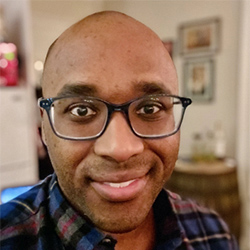 Jarrett Smith:
Jarrett Smith:
“I came to JHMI in 2011. I arrived with very little experience with actual bench science. I only had a few years of wet lab experience from Terry Snell’s lab at Georgia Tech so I was worried about being behind in grad school. I think it’s common to come into grad school with a strong case of Imposter Syndrome.
Luckily, I was able to dive into the science right away. I rotated in several labs – Marie Hardwick’s, Peter Espenshade’s, and Geraldine Seydoux’s. All of these rotations were a huge learning experience for me. During my time in Geraldine’s lab and in the MBG department, I started to feel like I might be able to do this science thing – that was one of my big reasons for joining her lab and the department.
MBG is a deeply supportive department. Geraldine was a big proponent of attending departmental seminars and journal clubs and I always got something out of them. But even more than that, I was in constant communication with the people around me. Trainees and PI’s from other labs invested time in talking to me about my project. Consequently, I became invested in the department. I contributed to journal club and seminar discussion, and I made a point to offer input on the projects of more junior grad students.
One of the best examples of the impact the department had on my development as a scientist was the mentorship I received from Rachel Green. Rachel’s lab was across the hall from Geraldine’s lab and there is a close back-and-forth collaborative dynamic between the two. Rachel became a huge mentor for me, giving me feedback on presentations and being very generous with her time in helping me troubleshoot aspects of my project. I learned the value of having mentors inside and outside your lab. Being exposed to her work on translation inspired my postdoctoral research interest and she played a big role in helping me choose my postdoc lab. I think that the environment that MBG cultivated contributed to these kinds of interactions.
Soon after I Ieft Hopkins for my postdoc with David Bartel at The Whitehead Institute, I applied for a postdoctoral fellowship – HHMI’s Hanna Gray Fellowship. I had a lot of support from members of MBG in the form of letters of recommendation. On one of the biggest days of my life, I was awarded the fellowship. I received many phone calls and emails from people here at the Whitehead, but I also had people from MBG reaching out to congratulate me. It was great to feel support from both ends of my scientific life.
Now in the slightly more distant future, I still have a lot of strong scientific and social connections that come directly from my time in MBG. The positive impact that the department has made on my scientific career is clear and invaluable.”
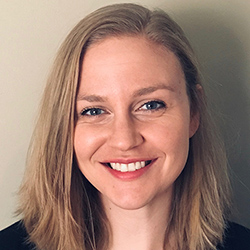 Karole D’Orazio:
Karole D’Orazio:
“I finished my PhD at MBG and moved to Boston for my postdoc the summer of 2020. Moving during a pandemic was certainly stressful, but I had developed a great network of peers in MBG and many of them had moved to Boston so it wasn’t as intimidating.
At first, I struggled to decide on a postdoc. But thanks to great advice and intuition from my MBG mentors, I ended up in a great lab. They encouraged me to interview somewhere I wasn’t expecting to choose and I ended up loving it because the lab was exactly my style.
The many journal clubs, seminars, and even happy hours in MBG helped me think about science in a critical and rewarding way. The scientists in MBG always pose interesting questions, are excited about new data, and have fun while doing it.
The MBG department really prepared me for my postdoc, particularly by giving me a solid background in fundamental research. The diversity of labs and styles in MBG set me up to feel confident to explore new systems and feel brave enough to ask questions in fields I had never considered before.
MBG gave me the confidence to do this on my own and that has been a valuable thing.”
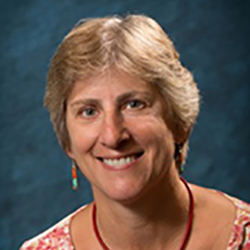 Marisa Bartolomei :
Marisa Bartolomei :
“I finished my PhD with Jeff Corden in 1987. I was his first graduate student. After graduation, I went to Shirley Tilghman’s lab at Princeton for my postdoctoral work. After that, I started as an Assistant Professor at Penn.
Penn has changed a lot over the years and has become very broad-thinking. I enjoy working with the students. In many ways, it reminds me of my own graduate experience at MBG, in which I felt that I had a lot of personalized attention in an incredibly dynamic and exciting research environment.
When I started at MBG, Jeff Corden was one of the first of a new cohort of Assistant Professors to be hired. As a trainee, I was exposed to young faculty members like Jeff, people with new technology and exciting science who were eager to mentor trainees.
My trainees now experience the same thing – there is a lot of interaction with the faculty and postdocs. At MBG, faculty and postdocs were generous with their time, so I try to offer my trainees the same type of environment, including time with more senior members of my lab, with adjacent labs and with collaborators.
Dan Nathans especially was a wonderful person and lab leader. Jeff’s lab was so small that we used to go to the Nathans Lab for meetings. It was a wonderful, great time to be a trainee because you had a combination of brilliant, experienced people and new, young people doing interesting science.
There was one female postdoc and one other female graduate student when I arrived in the department. Johns Hopkins was like that back then – most major universities were similarly non-diverse. It’s important for trainees to see what the future could hold for them. They should be able to ask, ‘Does that person look like me?’”
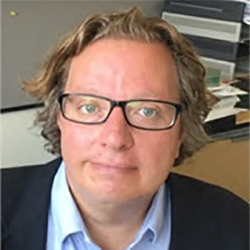 Michael Hemann:
Michael Hemann:
“I started working as a Research Technician at Children’s Hospital in Boston when I became interested in chromosome biology. Eventually I decided to enter the Human Genetics graduate program at Johns Hopkins.
In this program, Human Genetics students took classes with medical students. We had an intense introduction to human disease and conditions. It was an incredible opportunity to appreciate how doctors think and how medicine is applied in practice.
While I was doing rotations, I heard a talk by Carol Greider. She was still at the Cold Spring Harbor Laboratory then. The work she was doing in Biology was exciting and she was an engaging speaker.
I found out she was moving to Hopkins soon, so I asked if she would be willing to take a Human Genetics graduate student. It was an exciting time – in fact, some of the research I did in her lab is the work I am most proud of in my entire career.
In Carol’s lab, I became interested in cancer biology. It was inspiring to hear about Carol’s work, especially her story of how she got started in science. From my experiences in Carol’s lab, I knew I wanted to generate and improve cancer models. I was intrigued by basic science that could have a significant impact on human biology, and in doing research that would have human implications and applications.
We needed better mouse models, and this is something I worked on in Carol’s lab. If we can build better models of disease, then we can better predict the human response to therapies. Putting science in dialogue with medicine is crucial to understanding human diseases, and that is something I learned at Johns Hopkins.
At Hopkins, everyone seems to know that you are a part of something bigger than yourself. It’s a clinical enterprise of epic proportions, but then there is also an emphasis on the importance of the basic sciences.
As a graduate student, I encountered a very fluid interaction that went both ways: this proximity between the clinical environment and the research side was an essential part of my experience. There was always a sense of “How do you speak to a bigger problem?”
In the Human Genetics program, I learned that the enterprise of science is about speaking to big issues that affect humanity. Each side has something to gain from the other, and it’s important that scientists engage in collaborative processes.
In the last 20 years, the field of Cancer Biology has increasingly brought clinical work and scientific research together. New therapeutics are increasingly building bridges between science and medicine.
This was a given during my time at Hopkins. The interaction between basic research and clinical practice was implicit in how people did their science. You would regularly see people from both sides attending talks, interacting with each other, collaborating.
Being trained as a PhD student in this environment changes how you think about science. I began to understand the value of basic research in relation to clinical problems. Conversely, there was also a large number of medical doctors doing basic science research because they understood its value.
I’m a Professor of Biology at MIT now and we don’t have a clinical institute directly on campus. However, my experiences as a graduate student at Hopkins encourage me to make a consistent and constant effort to engage with clinicians in our community.
This can be a challenge for us sometimes. At a place like Johns Hopkins, it is built into the environment. During my time at Hopkins, I was surrounded by committed and brilliant people who understood the critical link between science and medicine, and how important it is to train future generations of scientists who can also appreciate that.”
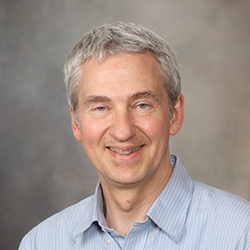 Steve Ekker:
Steve Ekker:
“I started at the University of Illinois where I completed a dual degree program in Developmental Biology and Electrical Engineering. When I started working on zebrafish, I was one of the only people with an electrical engineering background. Instead of coding computers, I wanted to figure out the code of life.
I knew I wanted to work with a Molecular Biology group. Hopkins had one of the only programs in this exciting new field. 29 students came through the umbrella program of BCMB with me, but I was one of the few of us who wanted to do DNA work. I liked the program at Hopkins because there was enough functional genetics going on that it made DNA work fun.
Phil Beachy’s lab was my third rotation, and I ended up becoming his first graduate student. I worked on a protein biochemistry project in which our goal was to figure out how a highly conserved class of transcription factors interact with DNA – I did a lot of structural and functional work, which I enjoyed.
One night I was working late and my classmate Nikola Pavletich came up to give me a chance to see the structure of a protein bound to DNA using 3D glasses. From this first ‘zinc finger’ protein structure, you could infer how this protein bound DNA – and potentially make changes to this protein to specifically bind to a different DNA sequence.
When I was a graduate student at MBG, this concept was the launch of modern gene editing tools. We understood their implications for future research, but none of us could quite imagine their potential as therapeutics. Working on the Hedgehog stuff in the Beachy Lab was also memorable – it was very fast-paced work.
After my PhD, I stuck around and did a postdoc at MBG because my wife was doing a graduate degree program in education at Loyola. We moved to Baltimore when we were newlyweds, so it was an adventure for us. I was supposed to be a temporary postdoc for a year, but I stayed longer because I ended up doing some interesting work.
In my first year of the postdoc, I cloned zebrafish and xenopus hedgehog genes while also working on biochemistry of fly and mouse hedgehog proteins. Getting training on this entire new class of cell signaling molecules, from biochemistry to in vitro biology to the development of entire organisms was rich and complementary training to my DNA binding protein work. Together, this combination of PhD and postdoc set me up for a wide array of scientific options to help me run my independent lab now for over 25 years.
At that time, there was a rich group of scientists at MBG focused on answering scientific questions that provoked their curiosity. I overlapped with Dan Nathans, Ham Smith, Jef Boeke, Srinivasan Chandrasegaran (‘Chandra’), Phil Hieter, Steve Desiderio and others, and I enjoyed learning in that rich and intellectually challenging environment.
I had a bit of an unusual postdoc. I worked closely with Randy Moon in Seattle as well, and we wrote several papers together. No one was doing zebrafish or xenopus work at MBG, so HHMI facilitated a lot of that research. It was an exciting time, and I think about it often in the modern world of COVID as I conducted multiple projects cross-country well before we had advanced internet technology (and before Zoom!). I did end up on a first name basis with the FedEx truck driver to MBG however.
Now I am a Professor at the Mayo Clinic, Dean of the Mayo Clinic Graduate School of Biomedical Sciences, and a founder of both a gene editing society (the Genome Writers Guild), as well as three biotech companies that use genome engineering. One of my favorite parts is getting to see the outcomes of this basic science work becoming new therapies – and in my lifetime.
At the Mayo Clinic, I collaborate closely with the clinical side and have the opportunity to conduct basic science to the clinic and get to directly explore the important human work being done at this wonderful institution. We are in a basic science building, but I’m always walking through our clinics.
When I first interviewed for a faculty position at Mayo, the environment felt immediately very familiar. The sounds of teams helping patients, the researchers next door working on new solutions, all seemingly unaware of the remarkable place and space they are busy working in. MBG was fantastic training for my professional path.
Working at Mayo is all about the patients and solving their problems – we have top science teams, and we never turn a patient away. These values are deeply reflected at Hopkins too.”